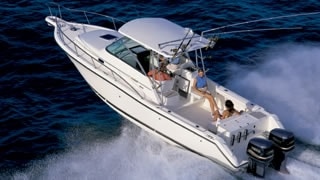
The 3070 Express from Pursuit has handily filled a couple of niches since it was introduced last season. Anglers looking to move up from their current 24- or 28-footers appreciate the extra space and seakeeping abilities of this larger model, while those ready to add more comfort to their fishing activities are finding that the 3070 fits their needs perfectly. By design, the 3070 is set up to do a little of everything, and defining it seems to be a bit of a challenge.
“It’s an express boat,” declared Bill Gilbert of Caribe Boat Sales in Islamorada, Florida, who provided the 3070 for our test ride. “It’s a walkaround,” answered David Glenn, Pursuit’s marketing director. “But it has a flush deck,” countered Gilbert, and on it went. Fact of the matter is that the 3070 encorporates both configurations.
In cockpit and helm configuration the 3070 is definitely an express design. From a discreet step molded into the forward cockpit corners, it features a generous 10 1/2-inch runway coming forward that widens to well over 16 inches before you break onto the bow deck.
Getting from the ‘pit to the pulpit is an easy traverse. Well-placed grab bars integral to the wraparound windshield frame are sturdy and in the right place to keep you glued to the boat even when seas are lumpy. The bow deck is enclosed in a one-piece, stainless bow rail that hits most people just above the knees. The rail is through-bolted or drilled and tapped into backing plates molded into the deck. This makes working forward to handle the anchor secure and safe.
The pulpit is standard on the 3070 Express, and the windlass is optional. To starboard in the forward bow deck is an immense anchor locker with a bitter-end tie-off and enough room to store a Danforth-style anchor in the hanging rack, all the rode you are ever likely to need, plus a spare anchor or two for backups or anchoring out.
The cabin is snug, but plenty serviceable for overnighting. A double berth lies along the port bow, with a cedar-lined hanging locker and head with shower aft of that. To starboard, a stacked service center includes a microwave, sink and storage beneath. The dinette lies opposite the head, and on the bulkhead above the countertop is the breaker and electrical panel, visible and easy to reach. Stairs leading down from the cockpit fold flat against the companionway bulkhead for access to a large area aft. There’s enough room here for another berth, if needed, though it might prove a bit close. It’s probably better to use the space for storage, or to accommodate a genset. However you use it, there’s no shortage of acreage.
| ¿ SPECIFICATIONS Length w/o pulpit: 30′ 10″ Beam: 10′ 6″ Water: 30 gals. Deadrise: 21 ¿ Fuel: 310 gals. Base price w/o power: $104,440 |
In fact, all the storage areas on the 3070 are roomy. Access to mechanical systems is simple and well placed behind flush hatches. An especially interesting feature is the battery tray, which is electrically activated to slide out within reach behind a hatch in the starboard transom bulkhead. When the tray is retracted, the batteries sit on the centerline, allowing access to pumps in the bilge below, through the same hatch.
The cockpit is roomy and well laid out for fishing. The bait well in the transom is flanked to starboard by a sink with a shower hose, and to port by a large transom door. An especially sturdy transom bench seat folds flat for storage and is hinged heavily enough to survive plenty of abuse without weakening. A handy jumpseat for watching baits is built into the back of the helm. This is a feature Pursuit appears fanatical about, and if you’ve ever spent time watching the wake, you know how convenient such a seat can be. Opposite the jumpseat, to port, is a built-in cooler backed up against the L-shaped passenger seat.
The bridgedeck is hinged at the forward edge, and raises on mechanical rams to reveal a monstrous, full-width compartment for rod storage – or storage of anything you want to lock away out of sight. The helm seat adjusts electrically fore and aft, and up and down. Access behind the instrument panel is simple, as the entire molded unit tips forward, giving you plenty of room to get your arms inside.
Our test boat was outfitted with a pair of 225-hp Yamaha four-strokes, which pushed the 3070 along easily at 46 mph at 6000 rpm. The hull rose quickly on plane with no noticeable up-and-down, responded nicely to the tabs and took turns quickly and nimbly. The hull stayed on plane down to 18 mph at 3100 rpm. Backing was consistent to port and starboard, and the hull spun nicely with the engines reversed. Fuel consumption at cruise was 17.6 gph, sliding along at 33 mph at 4300 rpm. Pushed to the pins, at 46 mph, fuel consumption jumped to 40 gph. These figures are slightly better than the manufacturer’s published performance figures. The 225s we tested are a good match for the hull. You’ll gain a bit more speed and not sacrifice fuel consumption at top end with the selection of Yamaha 250 HPDIs.
Pursuit Boats, Ft. Pierce, FL; (772) 465-6006; www.pursuitboats.com.









